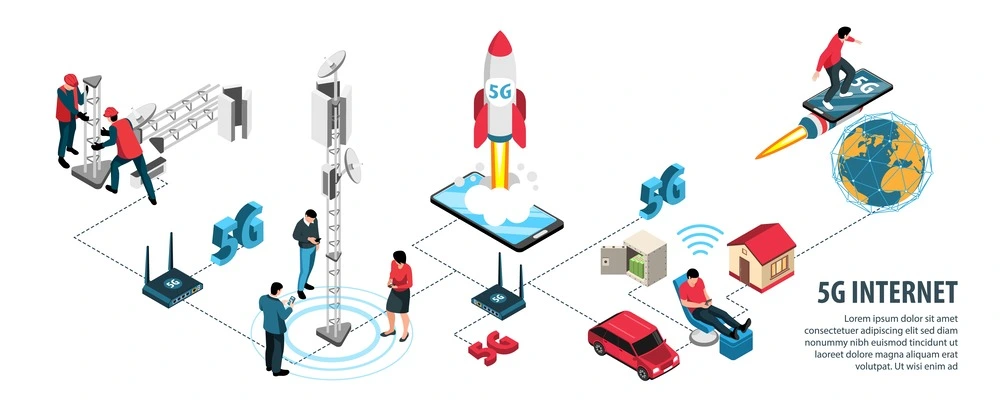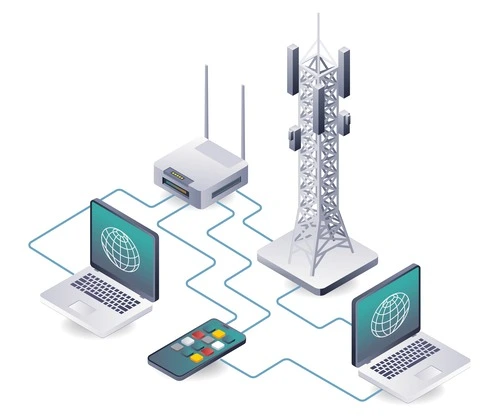Introduction: Understanding Digital Transformation in Telecom
The telecom industry is at the forefront of digital transformation, driven by rapid technological advancements, evolving customer demands, and an increasingly competitive market. Digital transformation in telecom is not just about adopting new technologies; it’s about redefining business models, enhancing operational efficiency, and improving customer experience.
With the rise of 5G, AI, cloud computing, and IoT, telecom companies must adapt to stay ahead. Digitalization in telecom enables telecom operators to move beyond traditional voice and data services, offering high-speed connectivity, automation, and intelligent service management. As telecom companies embrace digital transformation, they can optimize infrastructure, reduce costs, and create innovative services that cater to the ever-changing demands of businesses and customers.
According to industry reports, telecom companies that embrace digital transformation can reduce operational costs by up to 30% and improve service delivery speeds by over 40%. These figures highlight why digital transformation in telecom is no longer optional but essential for survival in a competitive telecom landscape.
In this blog, we’ll explore the key drivers of digital transformation in telecom, the role of 5G, innovation in the sector, the importance of asset management reporting, and the future of telecom in the digital age.
Related blog: How to Streamline Telecom Network Management with GenAI
Telecom Industry Disruption: How Digital Technologies are Reshaping the Sector
The telecom industry has experienced significant disruption due to digital technologies. Traditional models that relied on fixed infrastructure and limited service offerings are being replaced by agile, software-defined networks that enable telecom companies to scale operations dynamically.

Key Digital Technologies Disrupting Telecom
- Cloud Computing & Virtualization: Telecom providers are moving from legacy infrastructure to cloud-native solutions that improve network agility, scalability, and cost efficiency.
- AI & Machine Learning: AI-driven analytics enable predictive maintenance, fraud detection, and personalized customer experiences.
- IoT & Edge Computing: Telecom providers leverage IoT networks and edge computing to offer faster data processing and real-time insights.
- Blockchain for Security & Transparency: Blockchain enhances data security, fraud prevention, and automated contract execution in telecom transactions.
With the adoption of these technologies, telecom operators can enhance network performance, reduce downtime, and create more resilient digital ecosystems.
5G and Digital Transformation: A New Era for Telecom Networks and Services
5G and digital transformation go hand in hand, revolutionizing connectivity with ultra-fast speed, low latency, and high bandwidth. The introduction of 5G unlocks new business models and expands the telecom industry’s role in enabling digital ecosystems.
How 5G Accelerates Digital Transformation in Telecom
- Enhanced Network Performance: 5G networks offer speeds up to 100 times faster than 4G, enabling seamless connectivity for businesses and consumers.
- Smart Cities & IoT Growth: With massive IoT connectivity, 5G supports autonomous vehicles, smart grids, and industrial automation.
- Cloud & Edge Computing: 5G integrates with cloud computing to enable real-time data processing and edge-driven analytics.
- Immersive Technologies (AR/VR): 5G powers high-definition AR/VR experiences, transforming entertainment, remote collaboration, and e-learning.
Telecom providers must modernize their infrastructure to leverage 5 G’s potential fully. This includes deploying network function virtualization (NFV), software-defined networking (SDN), and AI-driven automation for improved efficiency.
Telecom Innovation: Fueling Growth and Efficiency in the Telecom Sector
The telecom industry’s future hinges on innovation, with digital transformation paving the way for more innovative and efficient networks. To remain competitive, telecom providers must embrace automation, AI, and next-generation technologies that optimize service delivery.
Key Innovations Driving Telecom Growth

- Network Automation & AI-Driven Operations
- AI-powered automation helps telecom companies predict network failures, enhance security, and streamline customer support.
- Infraon ITSM helps telecom enterprises automate IT workflows, ensuring minimal downtime and improved service delivery.
- Digital Customer Experience (CX) Enhancement
- AI chatbots, self-service portals, and real-time analytics improve customer interactions.
- AI-based personalization enhances customer retention and revenue generation.
- B2B and Enterprise Solutions Expansion
- Telecom providers are moving beyond consumer markets, offering enterprise solutions such as managed IT services, cybersecurity, and cloud infrastructure.
- Platforms like Infraon’s IT Asset Management enable telecom companies to manage enterprise IT resources efficiently.
With innovation at its core, telecom transformation is driving efficiency, reducing operational costs, and opening up new revenue streams
The Role of Asset Management Reporting in Telecom Transformation
As telecom networks become more complex, the need for accurate asset management and reporting is more significant than ever. Telecom operators manage vast infrastructures, including network towers, servers, fiber optic cables, and IT equipment. Telecom providers risk inefficiencies, compliance issues, and financial losses without proper asset tracking and reporting.
Why Asset Management Reporting is Critical In Telecom
Optimized Resource Utilization – Accurate asset reporting helps telecom operators track hardware, software, and network components, ensuring optimal resource allocation.
- Regulatory Compliance & Security: Telecom is a heavily regulated industry. Reporting ensures compliance with data protection, cybersecurity, and telecom laws.
- Cost Reduction & ROI Maximization: Efficient asset tracking minimizes losses due to mismanagement, unauthorized usage, or redundant assets.
- Predictive Maintenance & Downtime Reduction: AI-driven asset management enables telecom providers to predict failures, automate maintenance, and prevent costly downtimes.
Related blog: Enhancing Telecom Customer Experience: Leveraging NMS for Superior Quality of Service
How Infraon Supports Asset Management in Telecom
Infraon offers a unified IT Asset Management platform that enables telecom companies to:

- Track and manage network assets in real-time
- Automate asset lifecycle management to reduce manual errors
- Ensure compliance with telecom regulations through automated audits
- Optimize infrastructure costs with intelligent asset utilization analytics
By integrating Infraon ITAM & Infraon ITSM, telecom companies can achieve seamless digital transformation with centralized visibility over their assets.
Conclusion: The Future of Telecom in the Digital Age
The telecom industry is undergoing a massive digital shift driven by advancements in 5G, AI, cloud computing, and IoT. To stay competitive, telecom providers must embrace digital transformation, automate processes, and optimize asset management.
The future of telecom is digital, and those who embrace intelligent automation, AI-driven analytics, and agile asset management will lead the industry. Infraon’s IT and asset management solutions provide telecom companies with the tools to optimize operations, reduce inefficiencies, and drive business growth in the digital age.




















